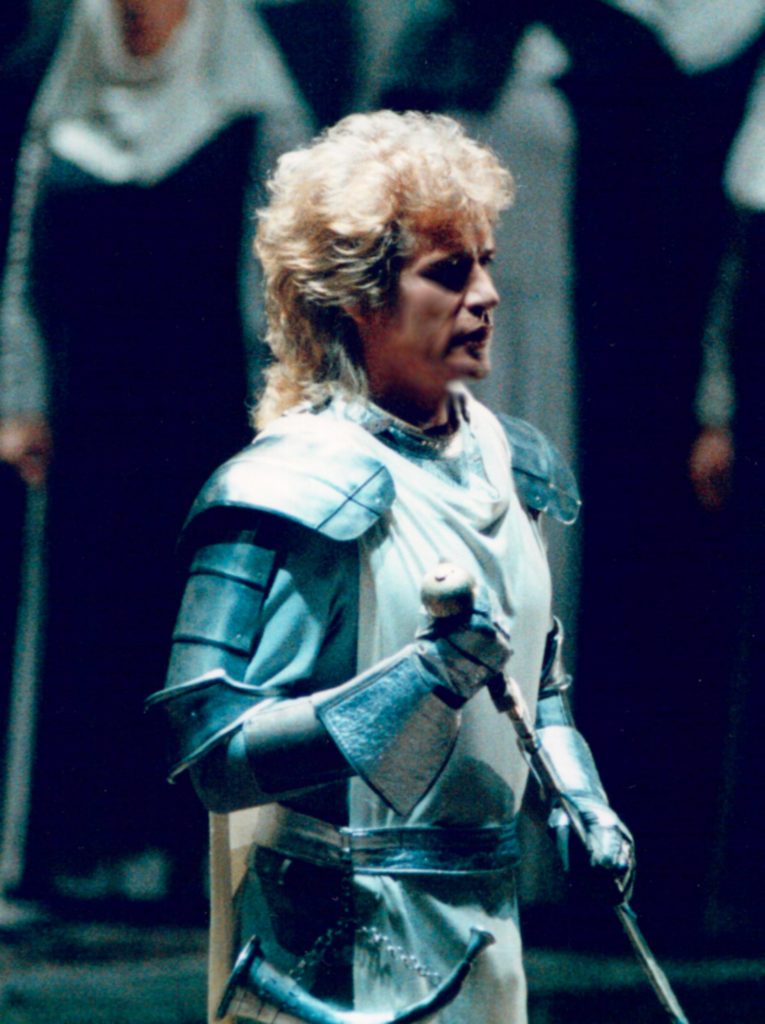Richard Wagner’s Lohengrin received its premiere in the Thuringian (central German) city of Weimar on August 28, 1850: 173 years ago yesterday. Conducted by Weimar’s Kapellmeister – the extraordinary Franz Liszt (1811-1886) himself – the premiere was a smash and Lohengrinhas remained a pillar of the operatic repertoire since.
As we observed in yesterday’s Music History Monday – which offered up a synopsis of Lohengrin’s action – the opera contains a thinly-veiled paean to German national virtue. But more than that, it is an Adam-and-Eve-like story of temptation and the power of evil to make an otherwise innocent person act on temptation, to disastrous consequences.

The action of the opera revolves around two couples: one good, one bad, and an ugly situation.
Couple Number One: The Good.
Elsa is the Duchess of Brabant, living in what is today the Belgian city of Antwerp. “The Nameless Knight in Silver” (a.k.a. Lohengrin) is Elsa’s mysterious savior, who shows up in Antwerp in a little boat drawn by a swan, there to act as Elsa’s champion against the scoundrel who has accused her of killing her own brother.
Couple Number Two: The Bad.
That scoundrel is Telramund, a once-honorable nobleman. The puppet-master behind Telramund is his wife, Ortrud. Ortrud is a total piece of work, power-hungry witch who worships – and draws her dark magic from – the pagan gods. Ortrud is as rotten as they come, and we love her for it!
The Situation: Ugly. The Silver Man has answered Elsa’s call, and in exchange for being her champion, Elsa vows to marry him immediately. (Talk about a brief engagement.) However, there is, as always, a catch: Elsa may never ask the Knight in Silver his name, or where he’s from, or what he does for a living. By itself, this is not the “ugly situation,” though it is, even as operatic plot devices go, completely unbelievable. No, the ugliness lies in the manner and ease with which Ortrud manages to poison Elsa’s mind, thus forcing her to ask her husband’s name and lineage! (Oh, horrors!) Elsa’s betrayal of her vow to Lohengrin brings about catastrophe, and by the time the opera concludes, Telramund, Elsa, and Ortrud are all dead and Lohengrin has sailed away into the sunset.
Sampling three different video performances, we will meet these four characters – Elsa, Lohengrin, Ortrud, and Telramund – in an effort to zero in on one particular, prescribed performance.
Upfront: all three of the performances are traditionally staged. For example, in the performances we will sample, there will be no “reimagined,” “updated” versions of the the opera. For example, we’ll see no dancing giant mice (à la The Nutcracker!), as there are in the Bayreuth Festival version conducted by Andris Nelsons; there will be no versions of the opera set inside a power station, where characters have detachable wings and where bad people are electrocuted rather than beheaded, as there are in the Bayreuth Festival version conducted by Christian Thielemann on Deutsches Gramophone.
The Scenes We Will Discuss and Compare
We will compare three particular scenes from Lohengrin, one from each of the opera’s three acts. From Act I the miraculous arrival of the swan-borne Knight in Silver (Lohengrin) and his duet with the awestruck Elsa. From Act II, the duet between the dupe Telramund and his sinister wife, Ortrud. Finally, from Act III, the denouement, the “moment of truth”: the conclusion of the opera.
If we truly want our singers to look the part, then there was no better tenor for the role of Lohengrin than Peter Hofmann (1944-2010), whose Aryan bona fides make him the “poster-Lohengrin” of his generation. Raised in Darmstadt, in what was then West Germany, he sang in rock bands as a teenager and was, as well, an elite, decathlon athlete. It was only during a seven-year stint as a paratrooper in the West German Army that he began to take voice lessons. After his honorable discharge, he went on to study voice and opera at the University of Music in Karlsruhe (the Hochschule für Musik Karlsruhe).
Sadly, Hofmann’s vocal prime didn’t last for long; he made his operatic debut in 1972, and by the late 1980s vocal problems forced him to retire from the opera stage. He briefly recreated himself as a singer in musicals and, among other things, as an Elvis impersonator (I kid you not). Sadly, early onset dementia and Parkinson’s disease soon brought an end to all of his musical activities, and he died in poverty, confined to a wheelchair, aged far beyond his 66 years.
Hoffman recorded two video performances as Lohengrin, the first at the Bayreuth Festival in 1982 and the second at the Met in 1986. Let us take a look and listen to Hofmann’s two Lohengrins.
Lohengrin, Act 1: Lohengrin and Elsa meet
Hofmann’s 1982 Bayreuth production performance show him at the top of his form. His squillo – that piercing, pinging, resonant, almost trumpet-like quality of his voice – is in its full glory, allowing his lyric tone to float effortlessly above Wagner’s often heavy orchestration.…
Continue reading, only on Patreon!
Become a Patron!